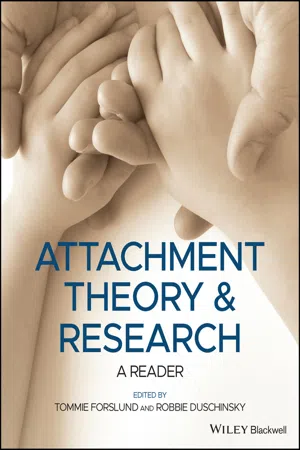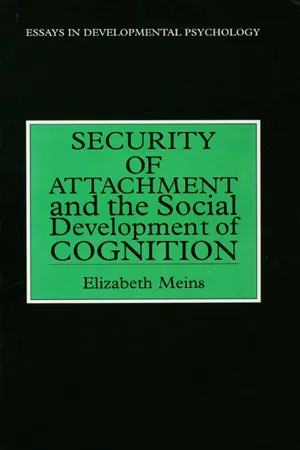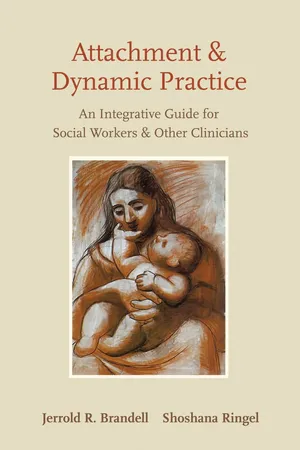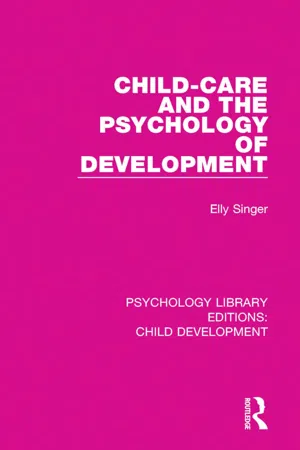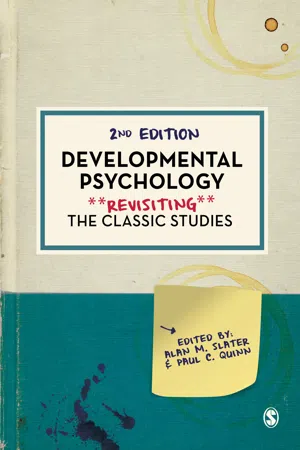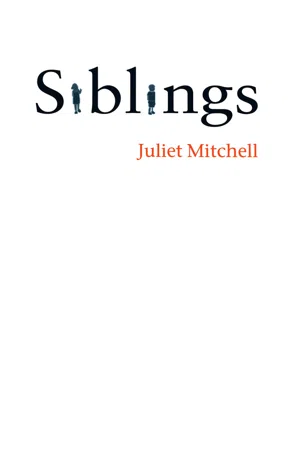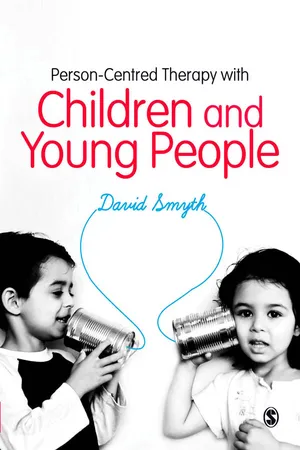Psychology
Bowlby Theory of Maternal Deprivation
Bowlby's Theory of Maternal Deprivation suggests that a child's separation from their primary caregiver, particularly the mother, can lead to long-term psychological and social difficulties. According to Bowlby, the absence of a nurturing and consistent maternal figure during early childhood can result in attachment issues, emotional instability, and behavioral problems in later life.
Written by Perlego with AI-assistance
Related key terms
Related key terms
1 of 4
Related key terms
1 of 3
10 Key excerpts on "Bowlby Theory of Maternal Deprivation"
- eBook - ePub
Attachment Theory and Research
A Reader
- Tommie Forslund, Robbie Duschinsky, Tommie Forslund, Robbie Duschinsky(Authors)
- 2021(Publication Date)
- Wiley-Blackwell(Publisher)
Subsequent reviews of the literature (Ainsworth, 1962 ; Ainsworth & Bowlby, 1953 ; Bowlby, 1952) led to a distinction between “maternal deprivation” as insufficiency of interaction of a child with the mother figure and “mother–child separation” as discontinuity of the bond of child to mother after it had become established. Although prolonged deprivation beginning before an infant had become attached to its mother was shown to have a very adverse effect on development (e.g., Goldfarb, 1943), in most of the research literature deprivation and separation were confounded, dealing with infants and young children removed from home and parents to whom they had already become attached and placed in an unfamiliar environment among unfamiliar caregivers, none of whom had sufficient interaction with the child to substitute as an adequate mother figure. Noting similar adverse effects, Bowlby directed research that shifted its main focus from outcome to process in an attempt to understand the sequence of responses a young child shows when separated under depriving circumstances and, also, to account for the sequence of readjustments in the child’s behavior toward his or her family when eventually they are reunited. These responses are reviewed in the introductory sections of each of the three volumes of his Attachment and Loss series (Bowlby, 1969, 1973, 1980) and are so focal to his theory that they will be summarized here. Three phases of response to major separation may be identified in children between the ages of one and four years: (1) protest, in which the child, both distressed and angry, tries by all means possible to regain the mother; (2) despair, in which the child becomes withdrawn and apathetic, with muted protest, and seems to have lost hope that the mother will return; and (3) detachment, in which the child’s longings for the mother and anger at her abandonment of him or her seem to have disappeared - Elizabeth Meins(Author)
- 2013(Publication Date)
- Psychology Press(Publisher)
cope with this separation. I shall also consider the possibility that the causes of such individual differences lie in the patterns of early dyadic interaction between infant and mother. In order to put these ideas into context, it is first necessary to consider the ideas of those who placed the child’s tie to the mother at the focal point of their work: Bowlby (1958, 1969) and Freud (e.g. 1931).Bowlby’s Theory of AttachmentRegardless of whether researchers agree with his theoretical claims, John Bowlby’s theory of attachment (1958, 1969) represents the starting point for research into the relationship between infant and caregiver. The theoretical emphasis of his work thus underpins, to varying degrees, virtually all subsequent work on the infant-mother attachment relationship.The original spur for Bowlby’s investigation of the tie between a mother and her child came from observations he made in his first job, working as a volunteer at a school for maladjusted children. The problems that he encountered in these children convinced him of the importance of balanced family relationships in the development of a psychologically healthy personality, and led to his decision to train as a child psychiatrist (Senn, 1977). In the 1940s, Bowlby embarked on a number of studies which investigated the adverse effects of maternal deprivation and institutional care on children’s psychological well being. This background made him an obvious choice for the World Health Organisation (WHO) when they sought to commission an investigation into the mental health of children made homeless or orphaned by the Second World War. Bowlby first published his findings in a report to the WHO in 1951, in which he detailed his views on the importance of maternal care for the child’s subsequent mental health. Bowlby’s first exposition of a theory of infant-mother attachment- eBook - ePub
Attachment and Dynamic Practice
An Integrative Guide for Social Workers and Other Clinicians
- Jerrold Brandell, Shoshana Ringel(Authors)
- 2007(Publication Date)
- Columbia University Press(Publisher)
Bowlby’s empirical study involved recorded observations of forty-four children from the London Child Guidance Clinic, where many of his subjects had been engaged in antisocial behavior such as stealing and aggression (Bowlby, 1944). From 1936 to 1939, he collected data on these boys, whose ages ranged from six to sixteen. The children, whom Bowlby termed “affectionless,” had been accused of stealing and displayed behaviors ranging from depression to hyperactivity and detachment. Bowlby explained in his paper that the cause of theft and aggressive behavior lay in the child’s attempts to get something that represented his mother’s love: “The food they stole was no doubt felt to be the equivalent of love from the mother whom they had lost, though probably none was conscious of the fact” (Bowlby, 1944, p. 121). The children’s mothers were found to have disturbed attitudes and behaviors, such as violence, anxiety, mental illness, and alcoholism. Bowlby’s perspective was that the children were expressing their need for love, and their anger over its absence, through their aggressive and delinquent behavior. He suggested that they were difficult to work with because they had developed a tough exterior in order to protect themselves against further rejection and loss (Bowlby, 1944).In 1948 the World Health Organization (WHO) commissioned Bowlby to do a study on the psychiatric problems of homeless children. In 1950 he started to gather data from social workers and child psychiatrists in France, Sweden, Switzerland, Holland, and the United States, and a short time later he published the Maternal Care and Mental Health (1951) report. He found that professionals, despite living in different countries, made very similar observations: that babies abandoned by their mothers and subsequently institutionalized, suffered developmental deficits and a greatly diminished capacity to relate to others. Many of these children were incapable of forming meaningful or lasting relationships. On the basis of his findings, Bowlby started to advocate that mothers, despite their poverty, receive as much support as possible in order to keep their children. Bowlby’s report had a significant impact on international public policy, particularly in adoption, social work, and hospital practices. It also contributed to a new understanding of the causes and prevention of child delinquency (Karen, 1998).In his next paper, “The Nature of the Child’s Tie to His Mother” (1958), Bowlby used findings in ethology to show that both animal and human off-spring have a need to be close to their mothers and this need for proximity supersedes the need for feeding. He compared human babies to the ducklings in Lorenz’s experiment, who followed whatever object they saw first after hatching, whether or not that object was capable of meeting their needs for sustenance. - eBook - ePub
- Elly Singer(Author)
- 2017(Publication Date)
- Routledge(Publisher)
innate tendency to remain close to his primary care-taker, and that adults – mothers in particular – have an innate tendency to remain close to the child and protect it (Bowlby, 1988:120–3).Bowlby hypothesized that this tendency to remain close developed during evolution: the children’s chances of survival were heightened. A newborn baby can do little other than cry when seeking close contact. Later, in relation to the mother, the child learns more active methods of gaining her attention: laughing, babbling, sitting, grabbing, throwing, crawling, walking and so on. The child forms a ‘working model’ or cognitive scheme of the environment (mother, other attachment figures, strangers), and its own behavioural alternatives for achieving its goal: close contact with the mother figure when it is feeling tired, afraid, sad or unsafe.Besides the need for close contact, the attachment theory also supposes a second innate tendency: the urge to explore the outside world. This supposedly developed during the evolution of man, and also had a survival value: contact with the outside world is necessary for making a living. Bowlby hypothesized that the infant’s urge to explore and play, which takes him away from his mother, counteracts his need for safety through proximity. The mechanism providing a balance between infants’ need for safety and their need for varied experiences was called by Bowlby ‘attachment’. Attachment is a highly evolved system of regulation geared to produce a dynamic equilibrium between the mother-child pair. At first the mother bears the greatest responsibility for maintaining the equilibrium of the attachment system. If the mother is ‘sensitive’, ‘responsive’, ‘available’ and responds promptly and adequately to the child’s signals, a secure attachment will develop (Ainsworth, Bell and Stayton, 1971; Bowlby, 1988: 119–36). The mother of a securely attached baby provides a secure base from which the baby can make exploratory excursions, coming back every so often to renew contact before returning to exploration. At times of distress the baby trusts that proximity with the mother can be sought and found. A sensitive mother gives the child the feeling of having control over her behaviour - eBook - ePub
Developmental Psychology
Revisiting the Classic Studies
- Alan M Slater, Paul C Quinn, Alan M Slater, Paul C Quinn(Authors)
- 2020(Publication Date)
- SAGE Publications Ltd(Publisher)
Harlow’s paper had an immediate impact on the ongoing debate about the importance of the mother-infant bond in child psychiatry. During the 1950s, John Bowlby, a British psychiatrist, had published a monograph (1951) on the effects of maternal deprivation on children’s development. In his visits to Harlow’s lab in the 1950s, Bowlby may have been responsible for pointing out to Harlow that his cage-raised monkey colony created conditions that were equivalent to partial social isolation (Suomi, Horst, & Veer, 2008). Harlow’s 1962 paper, in turn, lent support to Bowlby’s efforts to convince psychiatrists and other healthcare professionals that young children could be adversely affected by prolonged or inexplicable separations from their mothers (Horst & Veer, 2008).Harlow’s paper also directed attention toward measuring outcomes that had clear implications for overall adaptation and inclusive fitness. He called attention to motivational systems that served biological functions. In his view, the infant-caregiver bond served not only as a source of protection when confronted with danger, but also as a context in which the child acquired the capacity to form subsequent affectional bonds with peers, sexual partners, and offspring. This approach was influenced by European ethologists, particularly Robert Hinde, and by Harlow’s sensitivity to the effects of different rearing environments ranging from his lab, to the local zoo, to monkeys born and raised in the wild. Harlow’s creativity in designing laboratory environments that elicit attachment, fear, exploratory, and affiliative behavior showed a unique understanding of the importance of context in assessing how early social experience could influence subsequent development. He actively designed environments that tested the interplay between attachment, fear, and exploration. Peer and play environments provided contexts to assess the development of defensive and sexual behavior. The importance of context in observing and assessing behavior greatly expanded approaches to behavioral assessment and motivational systems. - eBook - ePub
Attachment Research and Psychoanalysis
Psychoanalytic Inquiry, 19.4
- Diana Diamond, Sidney J. Blatt, Diana Diamond, Sidney J. Blatt(Authors)
- 2017(Publication Date)
- Routledge(Publisher)
A central feature of caregiving that emerges in both traditions is the mother's ability to evaluate the child's developmental status and attune to the child's rhythms and needs. The emphasis of attachment theory and research on mothering is consistent with contemporary psychoanalytic approaches; both emphasize the interrelatedness between mother and child, the importance of environmental factors as major influences on development, and child pathology and developmental risk as related to maternal failure in the early years (Eagle, 1995). The mother is viewed as crucial in supporting age-appropriate development in the child (e.g., Sroufe, 1979; Solomon, George, and Ivins, 1987; Crittenden, 1995), including emotional attunement and empathy (Winnicott, 1958; Emde, Gaensbauer, and Harmon, 1976; Sroufe, 1979; Stern, 1985; Tronick, 1989). Further, the mother-infant bond is viewed in both traditions as fundamental to the quality of the child's later relationships (Bowlby, 1969, 1988; Mahler, Pine, and Bergman, 1975; Main, Kaplan, and Cassidy, 1985; Ainsworth, 1989; Thompson, 1999) and the stability and coherence of the self (Winnicott, 1958; Bowlby, 1969, 1980; Mahler et al., 1975; Emde, Gaensbauer, and Harman, 1976; Cassidy and Kobak, 1988; Main, 1990; Cassidy, 1994; Carlson, 1998).Historically, however, there have also been important differences in how the two traditions have viewed mothering. Detailed descriptions of maternal behavior have been a primary component of attachment theory and research from its inception. Bowlby's original conceptualization of attachment emphasized the behavior of the attachment figure as reciprocal and complementary to the infant's attachment behavior (Bowlby, 1969; 1980). During Bowlby's era, developmental research depicted the early capabilities and achievements of human infants. Bowlby (1969), thus viewed the infant as primed toward interaction and seeking contact with attachment figures and the mother as an active dyadic partner beginning at birth. Attachment theory's empirical approach to mothering is tied to Ainsworth's definition of attachment security. Ainsworth described mothering in terms of four broad interactive components. Chief among these was maternal sensitivity, defined as prompt and appropriate response to infant signals. Maternal acceptance, psychological availability, and cooperativeness were highly intercorrelated with sensitivity (Ainsworth et al., 1978). Three decades of research have demonstrated that mothers who provide sensitive and responsive care foster secure attachment and age-appropriate development; mothers who are insensitive, intrusive, or rejecting foster insecure attachment and compromise development (see Thompson, 1999; cf., Solomon and George, 1999). - Then, back again in India a couple of years later, I read in Bowlby an exact confirmation of my earlier observation: children of multiple carers experience extreme anxiety when their mother leaves. But this time there was nothing intellectually problematic about this: such children were merely more insecure by definition as they had not had enough sole mothering. Yet why had Bowlby's understanding not come to me when my stepson first explained my observation? Why does the explanation still slip away from me and then come back but only with an obviousness that darkens the mind? There is, I think, something crucially important in the observation, but also some crucial shortcoming in the explanation. I am reminded that I get ticked off for my very standardized remarks about Bowlby; this happens, I now think, because I express my opinions childishly. That is to say, I speak from a childhood which hasn't had quite enough of a look-in and which thus returns like a symptom, a childhood of what was technically – that is, in Bowlby's terms – maternal deprivation. I had a full-time working mother from my very earliest infancy, two godparents who cared for me when my mother was away at work, and quite possibly there was screaming separation anxiety – except that what my mother recalled was my pre-verbal fury with her (not my relief) when she returned after an atypical weekend field-trip. Bowlby has been felt as a presence all my life because, metaphorically, I am the child he wrote about. Except that I cannot quite recognize myself in any of his descriptions. On the question of multiple carers, Bowlby has been corrected by his own followers. Ainsworth's famous study of Ganda children showed that multiply cared-for and maternally cared-for children show similar levels of separation anxiety. Of this, Jeremy Holmes says: the evidence shows that Bowlby was just plain wrong about multiple care-givers
- eBook - ePub
- Frederick Walborn(Author)
- 2013(Publication Date)
- Academic Press(Publisher)
Bowlby, Figlio, & Young, 1990 ).Bowlby, based on evolutionary theory, believed attachment evolved as a primary drive to protect the helpless mammalian child from danger. That is, due to the comparative weakness of humans, attachment became a basic instinct without needing a mediator like sustenance. It has been suggested that humans, due to their relative weakness to other creatures, learned and evolved to attach and to cooperate (Kohn, 1990 ).A further distinction between dependency and attachment is the temporal appearance of these two discrepant terms of development and relationships.Dependence is maximum at birth and diminishes more or less steadily until maturity is reached; attachment is altogether absent at birth and is not strongly in evidence until after an infant is past six months. The words are far from synonymous (Bowlby, 1969/1982, p. 228 ).Within the neopsychoanalytic literature, which emphasizes relationships instead of biological instincts, the expected maturation of the infant toward adulthood is from dependency, to independency, and ultimately to autonomy (Mahler, Pine, & Bergman, 1975 ). When two autonomous people encounter each other, they may then find love, instead of a relationship limited to dependency (Goldberg, 1993 ). Love, within the dependency paradigm, is based on two autonomous people encounters.The attachment literature further clarifies the process of this breaking free of the infant’s dependency (Fonagy, 2001 ). For example, if infants are securely attached, there is evidence that they are more likely, as adults, to experience less anxiety-laden romantic relationships (Feeney, 2008 - eBook - ePub
- (Author)
- 2012(Publication Date)
- M&K Publishing(Publisher)
The transition to motherhood and the childbirth experience are viewed as very special experiences that make a mother uniquely capable of caring for her child (Nystedt et al., 2008). Success in this long-term psychological process is associated with positive life-long outcomes for both the parenting mother and the child, and it is essential for the normal development of children and their maturation into competent adults. Evidence indicates that attachment begins as a result of dynamic psychological and physiological events during pregnancy, while the child is a fetus (Cranley, 1981). Mercer and Ferketich (1990) assert that the process of attachment in which a parent develops a lifetime’s emotional commitment to an infant is an interactive process that involves seeking and maintaining close proximity and exchanging fulfilling experiences. Ainsworth et al. (1978) contribute that in building the attachment relationship, infants need to be close to their mothers to cue their needs and mothers need to be close to their infants in order to respond to those needs. Mothers who are capable of responding appropriately to their infants cues and establish a mutual, reciprocal and synchronous relationship with their infants will build a secure attachment. Sensitive nurturing care is thought to be the basis of a secure attachment (Carlson et al., 1989), while insecure attachment is associated with unresponsive, rejecting and insensitive parenting (Teti et al., 1995). Insecurely attached children, compared with securely attached ones, are less competent in relationships with both peers and adults, more fearful of strangers, more likely to have behaviour problems (including social anxiety and withdrawal) and are more dependent on both peers and adults (Radke-Yarrow et al., 1985). A child’s attachment to a primary caregiver is believed to reflect the prior quality of interaction with that caregiver and to predict later socioemotional competence - David Smyth(Author)
- 2013(Publication Date)
- SAGE Publications Ltd(Publisher)
The image I formed was that home (the centre of Jessica's physical world) was disrupted when her father went off to work. When she started school, I sensed Jessica felt she was being ‘sent away’ from home. I described what Jessica might be experiencing and how her mother might address this. I suggested that before going to school, my client might agree with Jessica what they would do afterwards and it was important for Jessica's mother to remember the daily plan. In this way, Jessica would be able readily to ‘reconnect’ her attachment to her mother and override her sense of disruption that school seemed to present. I was pleased to hear this suggestion quickly proved effective.A study by Heinicke and Westheimer (1966) identified two forms of disturbance of emotional behaviour found in separated children: one of emotional detachment; the other its apparent opposite, an unrelenting demand to be close to mother. Quoting this study Bowlby says, of ten children, six ‘showed strong and persistent hostile behaviour to mother and negativism after their return home: no such behaviour was seen in the non-separated children’ (2005: 95). It is my sense that Jessica's short-lived episodes of intense hostility within an otherwise secure relationship suggested her early school experience upset her equilibrium.Magda Gerber, who was born in Budapest, believed that adults in Western countries had become too interested in doing everything to or for a baby rather than allowing the baby the personal freedom to find their own way (Gerber, 2002). She shared with other theorists a passionate desire to encourage practices supportive of children and families. My eyes alighted on Mooney's (2010) description of an occasion when she (Gerber) called a doctor (Emmi Pikler) to visit her daughter Erika who became ill with a sore throat. Gerber began to tell Pikler about Erika's condition and the doctor ‘shushed’ her and focused on the child. Respectfully, she asked the young child what hurt. Two things amazed Gerber: ‘how cooperative her daughter was with a stranger when she was feeling so poorly, and how serious and respectful the paediatrician treated her young patient’ (Mooney, 2010: 35–6).Attachment can predominate at times throughout an individual's life. In times of crisis, early attachment figures (such as parents), whose importance may have diminished as the individual moved towards adulthood, can once more become significant attachment figures.Children – the Expectations of others
Rogers (1961) describes the locus of evaluation in terms of it being external or internal (see also Chapter 2
Index pages curate the most relevant extracts from our library of academic textbooks. They’ve been created using an in-house natural language model (NLM), each adding context and meaning to key research topics.
Explore more topic indexes
Explore more topic indexes
1 of 6
Explore more topic indexes
1 of 4
